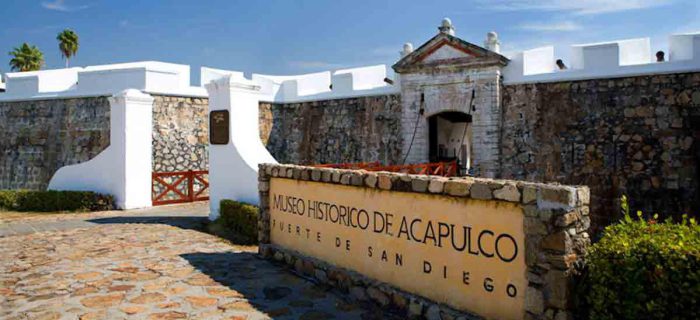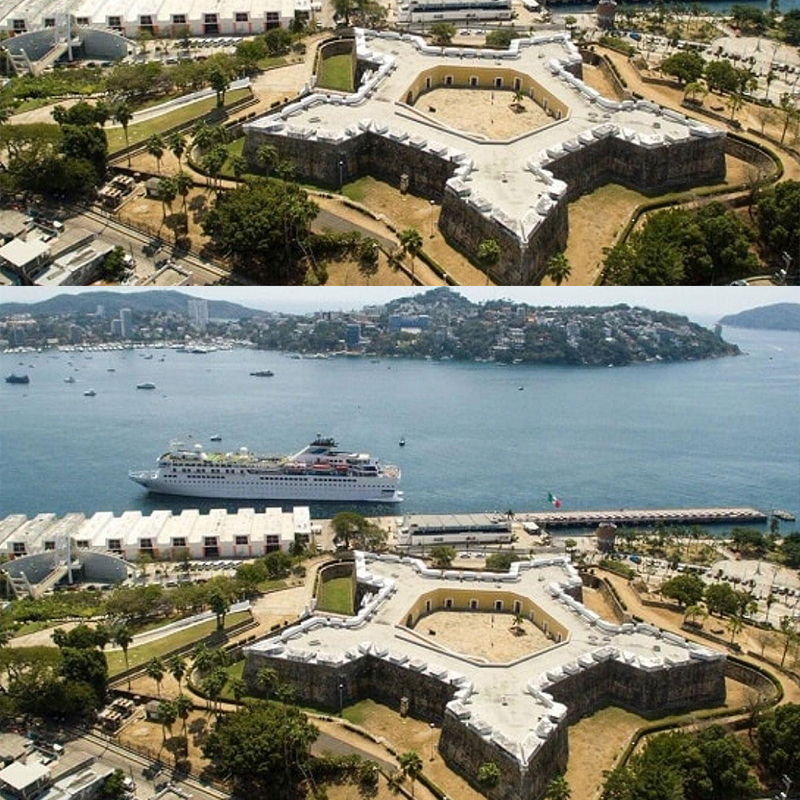Historical Museum of Acapulco Fort of San Diego
The Fort of San Diego is the most relevant historical monument in Acapulco and was the most important Spanish fortress along the Pacific coast.

Located on a hill in the heart of downtown Acapulco, the fort is an integral part of the landscape that stands out for its unique geometric design in the shape of a star.
Located on a hill in the heart of downtown Acapulco, the fort is an integral part of the landscape that stands out for its unique geometric design in the shape of a five-point star. This important building houses the Acapulco History Museum.
Contenido
Information
Through its 15 exhibition rooms or rooms, the museum tries to show the most relevant moments in the history of Acapulco and the important role that the fortress has played in the lives of local inhabitants. For the general public, the museum offers information on the events related to this important place, the old fortress gives an account of its rich past, the culture of the first inhabitants of the region, the conquest of the South Seas, trade with East. Piracy in the Pacific Ocean, the Mexican War of Independence and other relevant aspects of the place itself.
History
The Fort of San Diego was established by the Spanish Empire to secure Acapulco from pirate attacks, since the town was a considerable commercial port, being the departure point for the Manila galleons. The fort was first established by Viceroy Diego Fernández de Córdoba, Marquis of Guadalcázar, and was completed in 1617 according to the designs of the Dutch military engineer Adrián Boot.
The fort suffered enormous damage in an earthquake in 1776, and was demolished and restored according to the designs of Ramón Panón. The creation of the new fort began in 1778 and was completed in 1783. The new fort was named the Fort of San Carlos in honor of the reigning monarch, King Carlos III, but most of the crowd still called it the Fort of San Diego. . , and the new name was finally deprecated.

The fort was used throughout the Mexican War of Independence, and its garrison from Spain under the command of Pedro Antonio Vélez withstood insurgent assaults for many months until it fell to the Mexicans under the command of José María Morelos on August 19, 1813. The fort remained an active military installation. of the Mexican Battalion, serving the Secretary of War and Navy for 19th-century goals. The fort was also used throughout the French involvement in Mexico and the Mexican Revolution.
Exhibits of the Historical Museum of Acapulco in the fort
It was handed over to the Secretariat of National Assets and Administrative Inspection in 1949 to be converted into a military museum. It was administered by the National Center for Anthropology and History (INAH) until 1964, when it was handed over to the Ministry of Public Education to be used by the National Center for Fine Arts and Literature. In 1970 it was delivered to the Board of Material Updates of the Port of Acapulco and was used for cultural and artistic purposes.
The fort was returned to the INAH in 1980 and opened to the public as a museum in 1986. The museum is intended for Acapulco storytelling, and its exhibits have within it archaeological remains from the Mezcala civilization and artifacts related to the Manila galleons, piracy , the Mexican War of Independence, and exhibits on the fort itself.
taking of the fort
The war and capture of the Fort of San Diego occurred on August 20, 1813, after about 4 months of the beginning of the siege of the Plaza de Acapulco, a strategic bastion for the royalist forces of the Viceroyalty of Novedosa España, but also a very substantial purpose. for the insurgency.

José Morelos arrives with some 2,000 men determined on this occasion to take the fort, so much so that he divides his forces into three columns or groups, each commanded by men of enormous stature in the war of independence, each with a mission to at the end storm the castle of San Diego.
Colonel Pablo Galeana assaults and takes the Casa-Mata so much so that he controls a strategic position, General Julián Ávila takes the summit of Cerro de la Mira, and they already dominate two positions that compromise the fort quite a lot, in the end General Ávila attacks towards the center of the plaza of Acapulco and the royalists take refuge at the end in the fort.
Morelos grants another strategic order, commissioning Colonel Pablo Galeana to capture the island of La Roqueta, leaving the royalists without a supply route, this happened at the beginning of July and Galeana has been able to reduce the entry of supplies through the bay. In the end, the brave lieutenant colonel don Felipe González manages to reach the left flank of the castle facing terrible real fire, and Marshal Hermenegildo Galeana enters from the side of the ovens to the right of the castle.
At the moment there was nothing to prevent victory, there Morelos gives an honorable surrender to the intrepid true defender Colonel Pedro Vélez, who surrenders and distributes the castle to Morelos, who acting with great dignity and rectitude grants them a dignified treatment, and they were discharged at the end with military honors.
Archaeological and historical objects
The archaeological and historical objects that we can admire in the permanent exhibition rooms belong to the museum’s own collection and are enriched with loans from other institutions, such as the National Museum of the Viceroyalty and private collections, among which the antiquarian collection stands out. Lake Rodrigo Rivero.

These objects make up a remarkable heritage, as they speak of distant worlds that were brought together for more than two centuries through a trade route, as well as the region of the State of Guerrero with its interesting archaeological cultures, such as culture. of Mezcala, integrated with Mayan and Olmec influences, mixed with local groups, who managed to create ceremonial centers and a complex of figurines and masks with strong geometric traces known as the Mezcala style.
The Mezcala style has been defined by portable sculptures or figurines and flattened masks made with thick borders, lines and hollows with a great plastic feeling and symmetrically distributed within a rectangular or trapezoidal face, around a T-shaped border that constitutes The eyebrows and the nose. Numerous representations of animals, utensils, architectural models and representations of ball game constructions have also been found.
Services
The Museum has services such as a ticket counter, shop, auditorium, an educational services department that offers guided tours of the exhibition halls as well as the fortress itself, a temporary exhibition hall, ample parking space, gardens that show the visitor the place. Own species and, above all, a magnificent view of the port and the unique bay of Santa Lucía.
Acapulco represents the gateway to all the merchandise and influences of native cultures from various continents, it is a crossroads of races and peoples, home of the famous Manila Galleon and its fairs. The Museum keeps the most distinguished part of this history.
Prices and Hours
The museum is open to the public from Tuesday to Sunday. Admission on Sunday is free.






